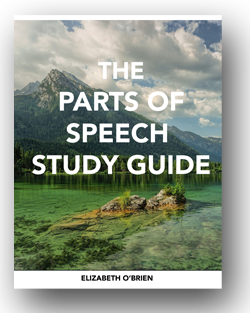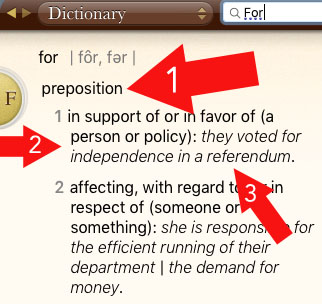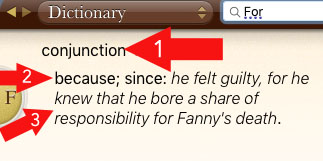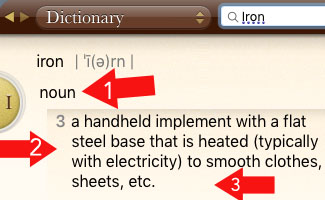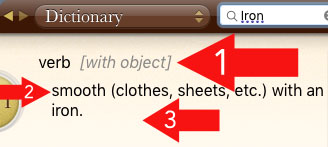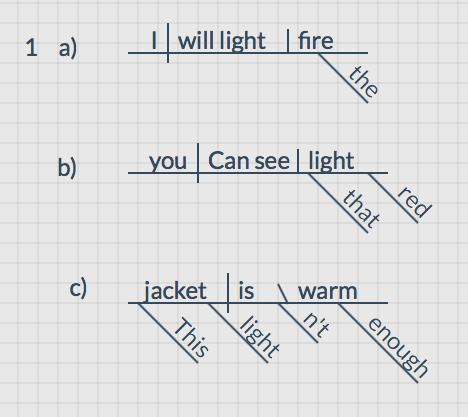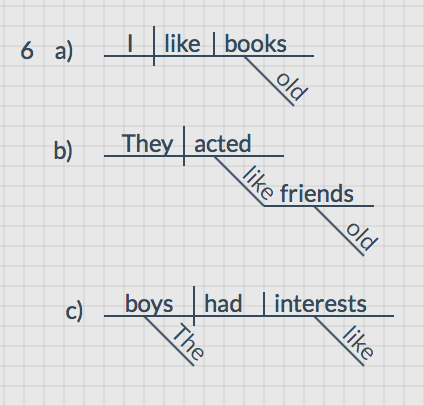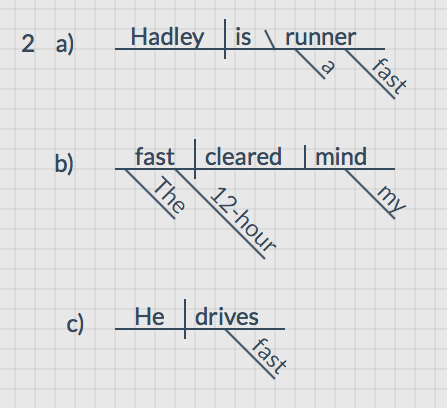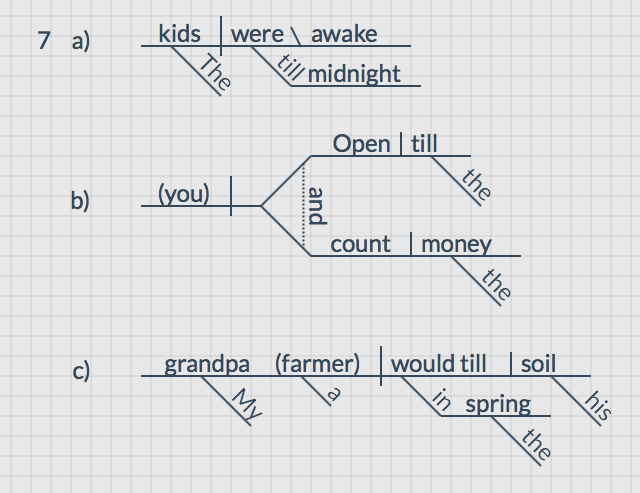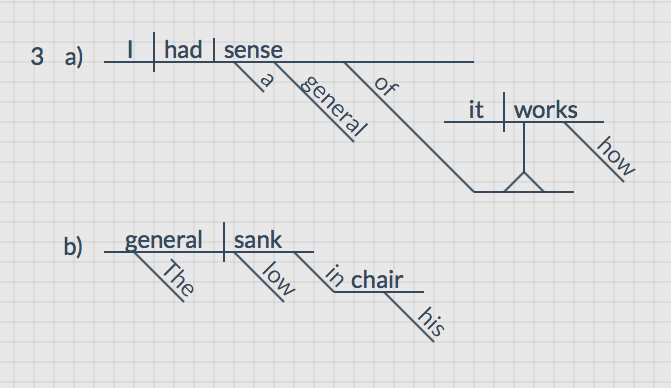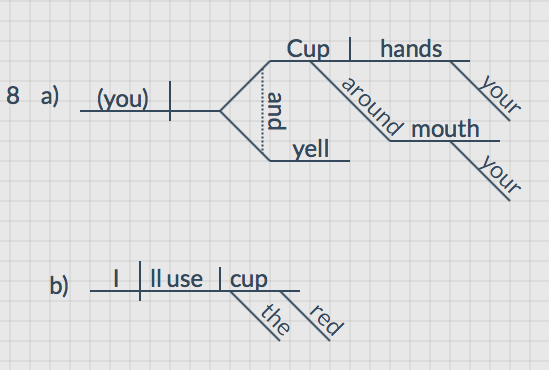If you’ve ever found yourself wondering what part of speech a word is, you’re not alone. In this lesson, we’ll explore how to answer that question as well as why that answer can seem a bit confusing. You’ll also find a quiz at the bottom of the page so that you can test yourself, along with a free PDF download. Jackpot!
Would you like to make this lesson more interactive?
Download the free ebook.
If you’d like to fill out your answers as you move through this lesson, download the guide before you watch the video.
If you’d like to print it out and you’re serious about conserving the ink in your printer, print only pages 4, 9, 10, and 11.
Pop quiz, hot shot! Let’s say you’re at the grocery store deciding between chunky and creamy peanut butter (tough choice) when someone walks up to you and asks, «What part of speech is the word love?»
Obviously, the first thing to do is run away from this person. But then, your mind might linger on that question, and you might start to wonder Hmm … what part of speech is the word love anyway?
At that point, you would probably think of some example sentences to figure it out.
I love peanut butter.
From this sentence, you might conclude that love is a verb since you know that verbs express action, and love is showing an action in this sentence.
You wouldn’t be wrong, but then you might think of this sentence:
Love for peanut butter brought me to the store today.
Wait a minute! Here, love is a noun. It’s an idea, and it’s the subject of the sentence. What’s the deal? How can love be a verb and a noun?
Here’s a secret about the parts of speech that many people don’t realize:
Many words can function as more than one part of speech.
They will only be doing one part-of-speech job at a time, though. In our example sentences above, we can see that love can be a verb and a noun, and we can also see that it’s doing just one of those jobs in each sentence.
How can you figure out what part(s) of speech a word can be, and how will you know what the word is acting as in any given sentence?
The first thing to do is to study the parts of speech and understand how they work.
Here’s what you can do after you have a sense of what the parts of speech are and how they work:
What part(s) of speech can this word be?
Look up the word in a dictionary. Dictionaries will show you the possible parts of speech that a word can function as. You can use a dictionary that’s an actual book, an online dictionary, or your device’s built-in dictionary. The dictionary will list each word’s possible part of speech, and it will give you definitions for all of the meanings of a word within each part of speech.
What part of speech is this word in this sentence?
In order to figure out how a word is functioning, we need to look at the word within the context of a sentence. Look over your sentence, and then open up your dictionary. Match the meaning of the word in your sentence with the most fitting dictionary definition. Then you’ll be able to tell what part of speech it is in your sentence.
Let’s look at two examples of words acting as different parts of speech.
We’ll look at the words for and iron, and we’ll see them acting as different parts of speech. We’ll also take a peek at what the dictionary says for each word.
What part of speech are the words in bold?
I asked for pie.
I cried, for I knew that the pie was gone.
Where is the iron?
Please iron my shirt.
For
I asked for pie. (preposition)
1. Just below the word that you look up, you’ll find a listing for a part of speech. The first listing is usually the most common way that the word is used. For is most commonly used as a preposition.
2. Next, you’ll find definitions of the word for each part of speech. If there is more than one definition, they’ll be numbered. There are many definitions for for as a preposition, and here you can see two.
3. After the definition, you’ll often find an example of how to use the word as that part of speech and definition. You can see the examples in italics.
I cried, for I knew that the pie was gone. (conjunction)
1. Below all of the definitions for for as a preposition, we can see a listing for another part of speech. It’s here that we see that for can also be a conjunction.
2. Here’s the definition. It’s not numbered because there is only one entry for for as a conjunction.
3. Here is an example sentence for us. (It’s strange, though, that they also used for as a preposition in this example as well as a conjunction!)
Iron
Where is the iron? (noun)
1. The first part of speech listed under iron is noun.
2. The first two definitions of iron as a noun weren’t the ones used in the sentence above, but the third entry was what I was looking for.
3. They don’t give us an example sentence. Boohoo!
Please iron my shirt. (verb)
1. Underneath all of the definitions for iron as a noun, I came here which let me know that iron can also be used as a verb.
2. There’s only one definition for iron as a verb, so they didn’t number this entry.
3. Again, there’s no example sentence. Perhaps everyone at the dictionary company called in sick on the day that they had to write example sentences for iron.
Test Yourself
I. Label the Parts of Speech
Directions: Name the part of speech for the underlined word in each sentence. Use a dictionary if you need one. For extra credit, diagram the sentences. 
1. LIGHT
a) I will light the fire.
b) Can you see that red light?
c) This light jacket isn’t warm enough.
2. FAST
a) Hadley is a fast runner.
b) The 12-hour fast cleared my mind.
c) He drives fast!
3. GENERAL
a) I had a general sense of how it works.
b) The general sank low in his chair.
4. BEFORE
a) Practice piano before you play with your friends.
b) Practice piano before dinner.
5. ROLL
a) Roll the dice.
b) I will eat the soup with a roll.
6. LIKE
a) I like old books.
b) They acted like old friends.
c) The boys had like interests.
7. TILL
a) The kids were awake till midnight.
b) Open the till and count the money.
c) My grandpa, a farmer, would till his soil in the spring.
8. CUP
a) Cup your hands around your mouth and yell.
b) I’ll use the red cup.
9. DRIVE
a) The long drive through the countryside lifted my spirits.
b) I always drive within the speed limit.
10. BLUE
a) Everyone in the family photo wore blue.
b) Jackie lives in the blue house.
Would you like to download this lesson?
- 20 Pages
- Includes all of the instructions and exercises on this page
- 4 pages with blank space to write answers
- 7 pages of answers (All 24 sentence diagrams included)
- Printable
- If you only want to print out the pages where you’ll be writing (I’m looking at you, expensive ink cartridges.), print pages 4, 9, 10, and 11.
- FREE
II. Write Your Own Sentences
Directions: Write your own sentences using the words below. Make sure the word is being used as the part of speech indicated on the left side. Underline the word in your sentence. The first one is done for you. Feel free to use a dictionary!
1. Drive
Noun: The long drive through the countryside lifted my spirits.
Verb: I always drive within the speed limit.
2. Baby
Noun: ___________________________________
Adjective: ________________________________
Verb: ___________________________________
3. Up
Preposition: ________________________________
Adverb: ___________________________________
Answers
I. Label the Parts of Speech
1. LIGHT
a) I will light the fire. VERB
b) Can you see that red light? NOUN
c) This light jacket isn’t warm enough. ADJECTIVE
6. LIKE
a) I like old books. VERB
b) They acted like old friends. PREPOSITION
c) The boys had like interests. ADJECTIVE
2. FAST
a) Hadley is a fast runner. ADJECTIVE
b) The 12-hour fast cleared my mind. NOUN
c) He drives fast! ADVERB
7. TILL
a) The kids were awake till midnight. PREPOSITION
b) Open the till and count the money. NOUN
c) My grandpa, a farmer, would till his soil in the spring. VERB
3. ABOVE
a) I had a general sense of how it works. ADJECTIVE
b) The general sank low in his chair. NOUN
8. CUP
a) Cup your hands around your mouth and yell. VERB
b) I’ll use the red cup. NOUN
4. BEFORE
a) Practice piano before you play with your friends. CONJUNCTION
b) Practice piano before dinner. PREPOSITION
9. DRIVE
a) The long drive through the countryside lifted my spirits. NOUN
b) I always drive within the speed limit. VERB
5. ROLL
a) Roll the dice. VERB
b) I will eat the soup with a roll. NOUN
10. BLUE
a) Everyone in the family photo wore blue. NOUN
b) Jackie lives in the blue house. ADJECTIVE
* The sentence diagrams for 4, 5, 9, and 10 are available in the downloadable version of this lesson.
Answers for II. Write Your Own Sentences are also available in the free, downloadable version of this lesson.
Would you like to download this lesson?
- 20 Pages
- Includes all of the instructions and exercises on this page
- 4 pages with blank space to write answers
- 7 pages of answers (All 24 sentence diagrams included)
- Printable
- If you only want to print out the pages where you’ll be writing (I’m looking at you, expensive ink cartridges.), print pages 4, 9, 10, and 11.
- FREE
Would you like to see another example of this concept? Let’s look at how the word balance can be a noun or a verb, and how it can help you think about your life.
Download Article
Download Article
Parts of speech are categories that are used to describe each word’s function in a sentence. The best way to identify a word’s part of speech is to think about what role the word plays in the sentence, but there are also a few clues that can help you figure out the part of speech if you are unsure about the word’s function.
-
1
Identify naming words as nouns. A noun is any word that names a person, place, thing, or idea. Nouns can be concrete (Alice, dog, table, etc.) or abstract (beauty, independence, cycle, etc.).[1]
- Proper nouns are used to name a specific person, place, or thing, and the main words are always capitalized (Fred, New York, the Declaration of Independence).
- Nouns can be either singular or plural.
- Nouns can be possessive, in which case they typically end in ‘s or s’.
-
2
Know that pronouns stand in for nouns. Sometimes, a noun is not always named. Words that do not directly name a person, place, thing, or idea, but take the place of a word that does, are pronouns.[2]
- Some pronouns stand in for people’s names (he, our, they, hers, etc.).
- Other pronouns represent an object or idea (it, these, this, etc.).
- Pronouns may also stand in for very indefinite nouns that may be difficult to name without the use of a pronoun (everyone, no one, something, etc).
Advertisement
-
3
Recognize action words as verbs. A verb is any word that is used to express an action (run, cleaned, driven, etc) or being (is, was, been, etc). Verbs have multiple tenses that express when the action took place.[3]
- Auxiliary verbs (also known as helping verbs) are words that are used to change the tense of the main verb (will, did, would, etc.). These are still considered verbs.
-
4
Learn that adjectives modify nouns and pronouns. An adjective is any word that is used to modify or describe a noun or pronoun (blue, many, smart, etc.). Adjectives typically answer questions like «how many?», «what kind?», or «which one?»[4]
- Numbers are considered adjectives when they are used to answer the question «how many?»
- Articles (a, an, and the) are considered adjectives by many because they answer the question «which one?» However, some people consider articles to be a separate part of speech.
-
5
Know that adjective and verb modifiers are adverbs. An adverb is similar to an adjective in that it is used to describe or modify. Instead of modifying a noun or pronoun, however, an adverb modifies a verb or adjective (happily, extremely, then, etc.). Adverbs typically answer the question «how?», «why», «when?», or «how much?»[5]
- Adverbs may also modify other adverbs. (I ran very quickly.)
-
6
Understand that prepositions express relationships. A preposition is a word or phrase that is used to show the relationship between noun or pronoun and another element in the sentence (at, by, in, to, from, with, etc.). Prepositions are typically very short words.[6]
-
7
Identify words used to join clauses as conjunctions. A conjunction is a word that connects other words, phrases, or clauses (and, but, or, because, etc).[7]
- Coordinating conjunctions are used to join two clauses that are equally important to the sentence. There are 7 coordinating conjunctions: and, but, for, nor, or, so, and yet. (I like cats, but I don’t like dogs.)
- Subordinating conjunctions are used to join a main clause and a subordinate clause, which is less important to the sentence. (I went outside, although it was raining.)
-
8
Recognize exclamations as interjections. An interjection is a word or phrase used to express an emotion or feeling, such as surprise. (oh, wow, my goodness, etc). Interjections are capable of standing alone and are not grammatically related to the rest of the sentence. However, they can also be included in a sentence, separated by parenthesis, dashes, or comas on either side of the interjection.[8]
Advertisement
-
1
Learn the Subject-Verb-Object rule. Most sentences in the English language have the same basic structure: the sentence begins with the subject, followed by the verb, and then the object (if the sentence has an object). There are exceptions to this rule, but understanding the norm can help you identify the parts of speech in most sentences.[9]
- Both the subject and object of a sentence will contain a noun or pronoun. This means that a sentence that has both a subject and an object will contain a noun or pronoun both before and after the verb. (I ate the apple.)
- The subject and object may contain modifiers such as adjectives as well.
- When the sentence has a direct object, it will come directly after the verb. (I like cookies.) When the sentence has an indirect object, it will come after a preposition. (I gave the card to Frank.)
-
2
Understand correct adjective and adverb placement. Although there are certainly exceptions to the rules, the placement of adjectives and adverbs is usually very predictable. Understanding where these words are most often found can help you identify them in sentences.
- Adjectives are almost always found before nouns and pronouns (We look at a red dress.) or after the linking verb «to be» (The dress is red.)[10]
- When adverbs are used to modify adjectives, they are almost always found right before the adjective. (The meal was truly delicious.)[11]
- When adverbs are used to modify verbs, they may be found before the subject (Later I will walk to school.), directly before the verb (I will carefully clean the artifacts .), or directly after the verb. (I go to the park frequently.)
- Adjectives are almost always found before nouns and pronouns (We look at a red dress.) or after the linking verb «to be» (The dress is red.)[10]
-
3
Identify clauses and phrases to find conjunctions. Because conjunctions are typically found between two clauses or phrases, you should be able to identify one by looking for the clauses or phrases that it joins together. If the word comes between the two clauses or phrases and seems to join them, it is likely a conjunction.
- Conjunctions like «and» and «but» are sometimes used at the beginning of a sentence, although this is more rare. When it is done, you should be able to identify the other clause or phrase in the previous sentence.
-
4
Use exclamation points to identify interjections. Some interjection are followed by exclamation points because they express emotional responses.[12]
If you see an exclamation point, the word proceeding it may be an interjection, although exclamation points are used after other types of words as well.- Not all interjections are marked by exclamation points. Don’t rely on exclamations as the only way to recognize interjections.
- Another clue that a word might be an interjection is that it is used alone. If there are other words in the sentence, it is less likely to be an interjection.
-
5
Look for nouns and pronouns to identify prepositions. Prepositions are typically found before noun or pronoun phrases. (I went to the store.) This is because the preposition expresses the relationship of the noun or the pronoun to the previous part of the sentence.
- Keep in mind there may be an adjective, adverb, and/or article between the preposition and the noun or pronoun. These modifiers are all considered to be part of the noun or pronoun phrase. (We paid for the very expensive jeans.)
Advertisement
-
1
Recognize suffixes that are common in nouns. Although not all nouns contain one of these suffixes, many do. Understanding that they are most common in nouns can help you identify the part of speech of a word, even if you do not know its meaning. Look for the following suffixes to help identify nouns:[13]
- -ion (population)
- -sion (tension)
- -tion (attention)
- -acy (accuracy)
- -age (image)
- -ance (allegiance)
- -ence (permanence)
- -hood (childhood)
- -ar (scholar)
- -or (editor)
- -ism (idealism)
- -ist (realist)
- -ment (government)
- -ness (sadness)
- -y (beauty)
- -ity (capacity)
-
2
Know which suffixes are common in adjectives. Just as with nouns, there are certain suffixes that are most commonly used with adjectives (although there are exceptions). Committing the following suffixes to memory may help you identify adjectives in sentences more easily:[14]
- -al (clerical)
- -ful (wonderful)
- -ly (friendly)
- -ic (chronic)
- -ish (squeamish)
- -like (childlike)
- -ous (contagious)
- -y (yappy)
- -ate accurate
- -able (laughable)
- -ible (horrible)
-
3
Learn which suffixes are common in verbs. There are a few suffixes that are used with verbs more often than any other type of word. If you see one of the following suffixes on a word, it is likely that it is a verb:[15]
- -ify (typify)
- -ate (proliferate)
- -ize (rationalize)
- -en (tighten)
-
4
Remember that most adverbs share a common suffix. Adverbs are by far the easiest parts of speech to identify using suffix clues. This is because the majority of adverbs end in the suffix -ly (merrily, wonderfully, quickly, etc.). If you see a word that ends in this suffix, there is a very good chance that it is an adverb.[16]
- There are some words that end in -ly that are not adverbs (butterfly), so be careful not to overgeneralize.
- There are also a few adverbs that do not end in -ly (well, fast, very, etc.).
Advertisement
Practice Questions and Answers
Add New Question
-
Question
What part of speech is the word «has»?
«Has» is a verb because it expresses an action. Depending on the sentence it is used in, it may be a main verb (He has the flu) or an auxiliary verb (She has traveled to Spain), but either way, it is still a verb.
-
Question
What part of speech is an article?
Articles (a, an, and the) are considered by some to be adjectives because they modify nouns. Other people consider articles to be a completely separate part of speech.
-
Question
In the sentence «Spring flowers are very beautiful» what part of speech is «spring»?
«Spring» is an adjective because it modifies the noun «flowers.»
See more answers
Ask a Question
200 characters left
Include your email address to get a message when this question is answered.
Submit
Advertisement
-
Context is key, as some words can act as multiple different parts of speech, depending on their role in a sentence.
Advertisement
References
About This Article
Article SummaryX
To identify different parts of speech, analyze the function that the word plays in a sentence. If the word names a person, place, thing, or idea, it is a noun. Label a word as a pronoun if it takes the place of a noun. If you see a word that expresses an action, that is a verb, and words that modify a verb are adverbs. If a word modifies a noun or pronoun, it is an adjective. To learn how to identify prepositions, conjunctions, and interjections, read on!
Did this summary help you?
Thanks to all authors for creating a page that has been read 337,780 times.
Reader Success Stories
-
«I love this… The explanation was quite much understandable.»
Did this article help you?
Parts of Speech
Every word is a part of speech, each playing a specific role in a sentence. There are 8 different parts of speech including noun, verb, adjective, adverb, pronoun, preposition, conjunction, and interjection. Each word in a sentence plays a vital role in conveying the meaning and intent of the sentence.
What is Part of Speech?
The English language has thousands of words and every word has some function to perform. Some words are there to show action, some to join, and some to name something. And together, all the functions performed by words in the English language fall under Parts of speech.
Parts of Speech Definition
The parts of speech are the “traditional grammatical categories to which words are assigned in accordance with their syntactic functions, such as noun, verb, adjective, adverb, and so on.” In other words, they refer to the different roles that words can play in a sentence and how they relate to one another based on grammar and syntax.
Parts of Speech Table
| Types | Function | Examples | Sentences |
| Noun | Refers Things or person | Pen, Chair, Ram, Honesty |
Cars are expensive. This chair is of wood. Ram is a topper. Honesty is the best policy. |
| Pronoun | Replaces a noun | I, you, he, she, it, they |
They are expensive. It is of wood. He is a topper. It is the best policy |
| Adjective | Describes a noun |
Super, Red, Our, Big, Great class |
Super cars are expensive Red chair is for kids Ram is a class topper. Great things take time. |
| Verb | Describes action or state | Play, be, work, love, like |
I play football I will be a doctor I like to work I love writing poem. |
| Adverb | Describes a verb, adjective or adverb | Silently, too, very |
I love reading silently. It is too tough to handle. He can speak very fast. |
| Preposition | Links a noun to another word | at, in, of, after, under, |
The ball is under the table. I am at a restaurant. she is in trouble. I am going after her. It is so nice of him |
| Conjunction | Joins clauses and sentences | and, but, though, after |
First, I will go to college and then I may go to fest. I don’t have a car but I know how to drive. She failed the exam though she worked hard. He will come after he finish his match. |
| Interjection | Shows exclamation | oh!, wow!, alas! Hurray! |
Oh! I got fail again. Wow! I got the job. Alas! She is no more. Hurray! we are going to party. |
Parts of Speech Examples with Sentences
Noun
Examples: Luggage, Cattle.
Sentence: Never leave your luggage unattended.
In some places, cattle are fed barely.
Pronoun
Examples: who, either, themselves
Sentence: I know a man who plays the guitar very well.
Either of the two cars is for sale.
They enjoyed themselves at the party.
Adjective
Examples: kind, moving, wounder.
Sentence:
She is a kind person.
Boarding a moving bus can be dangerous.
Never poke a wounded animal.
Verb
Examples: Praise, Hate, Punish
Sentence: She always praises her friends.
I don’t hate anybody.
The boy has been punished by his teacher
Adverb
Examples: Always, enough, immediately
Sentence: we should always help each other.
We should be wise enough to understand what is good for us.
We should leave bad habits immediately.
Preposition
Examples: Off, Below, From. to
Sentence:
He plunged off the cliff
I live below the 9th floor.
I travel daily from Delhi to Noida.
Conjunction
Examples: whereas, as well as, so,
Sentence: The new software is fairly simple whereas the old one was a bit complicated.
The finance company is not performing well as well as some of its competitors.
He was ready so he may come.
Interjection
Examples: oops! whoa! phew!
Sentence: Oops! I forgot to mention her name.
Whoa! you drive fast.
Phew! That was close call, we had a narrow escape.
Parts of Speech Quiz
Choose the correct Parts of Speech of the BOLD word from the following questions.
1. Let us play, Shall We?
a. Conjunction
b. Pronoun
c. Verb
2. It is a good practice to arrange books on shelves.
a. Verb
b. Noun
c. Adjective
3. Whose books are these?
a. Pronoun
b. Preposition
c. verb
4. Father, please get me that toy.
a. Pronoun
b. Adverb
c. Adjective
5. His mentality is rather obnoxious.
a. Adverb
b. Adjective
c. Noun
6. He is the guy whose money got stolen.
a. Pronoun
b. Conjunction
c. Adjective
7. I will have finished my semester by the end of this year.
a. Interjection
b. Conjunction
c. Preposition
8. Bingo! That’s the one I have been looking for
a. Interjection
b. Conjunction
c. Preposition
Quiz Answers
1. c, 2. b, 3. a, 4. c, 5. a, 6. b, 7. c, 8. a
FAQs on Parts of Speech
Q1. What are Parts of Speech?
Ans. A word is assigned to a category as per its function, and those categories are together known as Parts of Speech.
Q2. What are the 8 Parts of Speech?
Ans. Noun, Pronoun, Adjective, Verb, Adverb, Preposition, Conjunction, Interjection.
Q3. How many Parts of Speech are there?
Ans. There are a total of 8 parts of Speech.
Q4. What Part of Speech is “our”?
Ans. Adjective. Eg. Our car.
Q5. What Part of Speech is “Quickly”?
Ans. Adverb. let us understand it with this example – Milk sours quickly in warm weather.
Parts of Speech. Principles of Classification of the Parts of Speech.
√ Parts of speech.
√ Semantic.
√ Morphological.
√ Syntactic.
√ Meaning.
√ Form.
√ Function
√ Meaning
Parts of speech
Parts of speech are grammatical classes of words which are distinguished on the basis of four criteria:
— semantic;
— morphological;
— syntactic;
that of valency (combinability)
1) Meaning. Each part of speech is characterized by the general meaning which is an abstraction from the lexical meaning of the constituent word. Thus, the general meaning of nouns is thingness (substance), the general meaning of verbs is action, state, process; the general meaning of adjectives — quality, quantity.
The general meaning is understood as categorial meaning of the class of words.
Semantic properties of every part of speech find their expression in their grammatical properties. If we take «to sleep, a night sleep, sleepy, asleep» they all refer to the same phenomena of the objective reality but belong to different parts of speech as they have different grammatical properties.
Meaning is supportive criterion in the English language which only helps to check purely grammatical criteria — those of form and function.
Глокая куздра штэка будланула бокра и кудрячит бокрёнка. V. V. Vinogradov
Green ideas sleep furiously.
Such examples though being artificial help us to understand that — grammatical meaning is an objective thing by itself though in real speech it never exists without lexical meaning.
2) Form, (morphological properties) The formal criterion concerns the inflectional and derivational features of words belonging to a given class. That is the grammatical categories they possess, the paradigms they form and derivational and functional morphemes they have.
With the English language this criterion is not always reliable as many words in English are invariable, many words have no derivational affixes and besides the same derivational affixes may be used to build different parts of speech.(e.g. «~ly»: quickly , daily , weakly(n.)).
Because of the limitation of meaning and form as criterion we should rely mainly on words’ syntactic functions (e.g. «round» can be adjective, noun, verb, preposition).
3) Function. Syntactic properties of any class of words are: combinability (distributional criterion), typical syntactic functions in a sentence. The three criteria of defining grammatical classes of words in English may be placed in the following order: syntactic, distribution, form, meaning (Russian: form, meaning, syntactic distribution).
Parts of speech are heterogeneous classes and the boundaries between them are not clearly cut especially in the area of meaning. Within a part of speech there are subclasses which have all the properties of a given class and subclasses which have only some of these properties and may even have features of another class.
So a part of speech may be described as a field which includes both central (most typical) members and marginal (less typical) members. Marginal areas of different parts of speech may overlap and there may be intermediary elements with contradicting features (modal words, statives, pronouns and even verbs).
Words belonging to different parts of speech may be united by common feature and they may constitute a class cutting across other classes (e.g. determiners or quantifiers).
Possible Ways of the Grammatical Classification of the Vocabulary.
The parts of speech and their classification usually involves all the four criteria mentioned and scholars single out from 8 to 13 parts of speech in modern English. The founder of English scientific grammar Henry Sweet finds the following classes of words: noun-words ( here he includes some pronouns and numerals), adjective-words, verbs 4 particles (by this term he denotes words of different classes which have no grammatical categories).
The opposite criterion — structural or distributional — was used by an American scholar Charles Freeze. Each class of words is characterized by a set of positions in a sentence which are defined by substitution test. As a result of distributional analysis Freeze singles out 4 main classes of words roughly corresponding to verbs, nouns, adjectives, adverbs and 15 classes of function-words.
Notional and Functional Parts of Speech.
Both the traditional and distributional classification divide parts of speech into notional and functional. Notional parts of speech are open classes, new items can be added to them, we extend them indefinitely. Functional parts of speech are closed systems including a limited number of members. As a rule they cannot be extended by creating new items.
Main notional parts of speech are nouns, verbs, adjectives, adverbs. Members of these four classes are often connected derivationally. Functional parts of speech are prepositions, conjunctions, articles, interjections & particles. Their distinctive features are:
— very general & weak lexical meaning;
— obligatory combinability;
The function of linking and specifying words.
Pronouns constitute a class of words which takes an intermediary position between notional and functional words: on the one hand they can substitute nouns and adjectives; on the other hand they can be used as connectives and specifiers. There may be also groups of closed-system items within an open class (notional, functional and auxiliary verbs).
A word in English is very often not marked morphologically. It makes it easy for words to pass from one class to another. Such words are treated as either lexico-semantic phonemes or as words belonging to one class. The problem which is closely connected with the selection of parts of speech is the problem of conversion.
There are usually the cases of absolute, phonetic identity of words belonging to different parts of speech. About 45% of nouns can be converted into verbs and about 50% of verbs — into nouns. There are different viewpoints on conversion: some scholars think that it is a syntactic word-building means. If they say so they do admit that the word may function as parts of speech at the same time.
Russian linguist Galperin defines conversion as a non-affix way of forming words. There is another theory by French linguist Morshaw who states that conversion is a creation of new words with zero-affix. In linguistics this problem is called «stone-wall-construction problem».
Another factor which makes difficult to select parts of speech, in English is abundance of homonyms in English. They are words and forms identical in form, sounding, spelling, but different in meaning. Usually the great number of homonyms in English is explained by monosyllabic structure of words but it’s not all the explanation.
The words are monosyllabic in English because there are few endings in it, because English is predominantly analytical. We differentiate between full and partial homonymity, we usually observe full homonymity within one pan of speech and partial — within different parts of speech. If we have two homonyms within one part of speech their paradigms should fully coincide.
Homonyms can be classified into lexical, lexico-grammatical and purely grammatical. We should differentiate between homonymity and polysemantic words.
The word “THE” is a Definite Article and an Adverb.Take a look at the definitions and examples below and you will see how this little word can be used as different parts of speech.
1. Definite Article
This word “The” is considered as a definite article because it is used to refer to something specific. It is also placed before a noun, if the audience already knows what is being referred to (there is only one or the subject has already been mentioned). For example, let’s look at the sentence below:
“The pope will visit the Philippines in 2015.”
“The” is used because there is only one pope in the whole world.
Definition:
a. used to indicate a person or thing that has already been mentioned or seen or is clearly understood from the situation
- Joe is the tallest boy in class.
b. used to refer to things or people that are common in daily life
- The moon is aligned between the Sun and the Earth.
c. used to refer to things that occur in nature
- The inner planets of the solar system are denser compared to the outer planets.
2. Adverb
Aside from acting as a definite article, “The” can also be used as an adverb. Take for example the sentence below:
“Since getting a new computer, he was able to produce outputs all the quicker.”
In that sentence, “the” serves as an adverb because it modifies the adjective quicker. Take note that the word can only be used as an adverb if it is used together with an adjective or another adverb which is in the comparative degree.
Definition:
a. than before: than otherwise —used before a comparative
- The sooner the better.
b. to what extent
- Mercury is the most cratered planet in our Solar System.
c. beyond all others
- The more the merrier.

